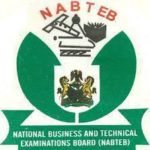2019 NABTEB GCE BIOLOGY PRACTICAL ANSWERS

2019 NABTEB GCE BIOLOGY PRACTICAL ANSWERS
*NABTEB GCE BIOLOGY PRACTICAL SOLUTION*
(1a)
(i) The malleus or hammar
(ii) The Incus or anvil
(1b)
_{Choose any two}_
(i)Blood transports oxygen in form of oxyhaemoglobin to all part of the body.
(ii)Blood transports nitrogen wastes from the tissues to the kidneys for excretion.
(iii)Blood helps to regulate the quantity of water in the tissue
(iv) Blood produces antibodies(lymphocytes) that destroy antigens.
(1c)
(i)xylem
(ii)phloem
(1di)
To disrupts the cell membranes and soften the cuticles and cell walls to extract the chlorophyll.
(1dii)
To break down the chlorophyll and taking the green color out of the leaf
(1e)
_{Choose any two}_
(i) water
(ii) Urea
(iii) carbondioxide
(1f)
(i) It is herbaceous plant.
(ii) It has an underground stem that can live for longer time.
(1g)
(i) Olfactory lobes
(ii) Cerebellum
(1h)
(i)External factors which includes availability of nutrients,humidity,light,temperation etc.
(ii)Internal factors which include the hormones.
(1i)
_{Choose any two}_
(i)Afforestation
(ii)contour ploughing
(iii)controlled grazing
(iv)Terracing
(vi)Re-afforestation
(1j)
_{Choose any four}_
(i)Atlas has a large neural canal
(ii)it has a flat and broad transverse process
(iii)The neural spine is very short or absent
(iv)it has no centrum
(v)Atlas has a vertebrarterial canal
(1k)
(i)cell sap or latex.
(ii)Blood.
(1l)
_{Choose any two}_
(i)They are epiphytes
(ii)presence of broad leaves
(iii)presence of buttress roots.
(1m)
(i)calyx (sepals)
(II)corolla (petals)
(1n)
Mendel’s second law of inheritance state that each character behaves as a separate unit and is inherited independently of any other character.
(1o)
_{Choose Any Two)_
(i)Liver
(ii)kidney
(iii)skin
(iv)Brain
====================================================
(2ai)
(i)Queen (Termite)
(ii) king (Termite)
(iii)Winged reproductive(Termite)
(iv)Soldier (Termite)
(2aii)
a – Head
b – Thorax
c – Abdomen
d – Wing
(2bi)
(i) Queen: The function of the queen is to lay eggs.
(ii) King: It mates or fertilises the queen.
(iii) Winged reproductive: They can become new queens or kings in a new colony after a nuptial or wedding flight.
(iv) Soldier: They defend the colony against enemies.
(2bii)
(i) Qeen Termite: They destroy wood and furniture by their feeding habits
(iii) Winged reproductive Termite: They produce a good source of protein and fats
(2c)
(i) Queen – Dead wood.
(ii)King – Dead wood.
(iii) Winged reproductive – Chambers under the ground.
(iv) Soldier – Dead wood and furniture
===================================================
(3ai)
Tilapia fish
(3aii)
Marine habitat
(3bi)
1 – Scales
2 – Fin rays
3 – Dorsal fin
4 – Lateral line
5 – Tail or caudal fin
6 – Ventral or anal fin
7 – Pelvic fin.
8 – Pectoral fin
9 – Opercullum or gill cover
10 – Mouth
11 – Nostril
12 – Eye
(3bii)
Part 1 – It cover and protect the skin
Part 4 – It is used for detection of vibration and pressure in water.
Part 5 – It aids movement in water
Part 8 – It is used for steering, balancing and protection.
(3c)
(i)Possession of fins for movement.
(ii)Possession of eyes for Osmo regulation.
(iii)Possession of gills for gaseous exchange.
====================================================
(4ai)
1 – Part containing a seed
2 – wing(an extension of fruit coat)
3 – Remains of style
4 – Fused pericarp and testa
5 – Position of embryo
6 – Point of attachment to the cob
7 – Scar left by style
(4aii)
VI – Dry dehiscent fruits
VII – Dry indehiscent fruit
VII – Dry indehisent fruit
IX – Dry indehiscent fruit
X – Dry indehiscent fruit
(4bi)
VI – Dispersed by Animals.
VII – Dispersed by wind.
(4bii)
VI – Desmodium may have hooks or hairs by means of which they adhere to the hairs of animal
VII – Combretum may have wings,so they are easily carried by the wind
(4c)
_{Choose Any Two}_
(i) It helps to prevent overcrowding of plants
(ii) It prevent undesirable competition for space, light, water and nutrients.
(iii) It prevents diseases from spreading among plant species.
(iv) It results in colonization of new areas with new plants.
=======================================================
(5ai)
XI – Female inflorescence of maize
XII – Pride of Barbados
(5aii)
1 – Filament
2 – Bract
3 – Anther
4 – Stigma
5 – Anther
6 – Filament
7 – Style
8 – Petal
9 – Nectary tube
10 – Ovary
(5bi)
4(Stigma) – Receives pollen grains at pollination.
5(Anther) – Contains the pollen grains.
8(Petal) – Attract insects which pollinate flower.
10(Ovary) – Contains the ovules, develops into fruit.
(5bii)
XI – Wind
XII – Insects
(5c)
_(Please tabulate)_
(XI):
(i) Flowers are dull in colour.
(ii) Flowers have no nectar.
(iii) Flowers are not scented.
(XII):
(i) Flowers are brightly coloured.
(ii) Flowers secrete nectar.
(iii) Flowers have scent.
Categories: NABTEB


